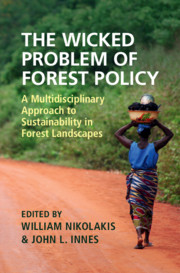 The Wicked Problem of Forest Policy
The Wicked Problem of Forest Policy Global Challenges, Multi-scale Innovations and Local Experiences
from Part I - Wicked Problems and Policies
Published online by Cambridge University Press: 24 July 2020
Addressing gender inequality is a core goal in the global development agenda. Gender inequality in forest landscapes is a ‘wicked problem’, where deep-seated socioeconomic and ideological causes are difficult to recognize and address, not only because they are context- and culture-specific across and even within countries, but also because they involve multiple (male and female) stakeholders with different and sometimes conflicting interests and different positions within power hierarchies. The alliances and tensions inherent in such complex stakeholder relationships may work with or against other desirable forest outcomes, and defy simple or superficial solutions. In this chapter, three forest policies are examined through the lens of gender equality: the devolution of forest management to local communities; payments to communities for sustaining forest-based global public goods; and forest certification. These policies have generated positive gender equality outcomes, but these also (re)produce gender discrimination through formal and informal institutions. More holistic approaches are required to address gender inequality in forest policies, which directly target gender and social relations, and strengthen women’s participation in forest governance.
To save this book to your Kindle, first ensure no-reply@cambridge.org is added to your Approved Personal Document E-mail List under your Personal Document Settings on the Manage Your Content and Devices page of your Amazon account. Then enter the ‘name’ part of your Kindle email address below. Find out more about saving to your Kindle.
Note you can select to save to either the @free.kindle.com or @kindle.com variations. ‘@free.kindle.com’ emails are free but can only be saved to your device when it is connected to wi-fi. ‘@kindle.com’ emails can be delivered even when you are not connected to wi-fi, but note that service fees apply.
Find out more about the Kindle Personal Document Service.
To save content items to your account, please confirm that you agree to abide by our usage policies. If this is the first time you use this feature, you will be asked to authorise Cambridge Core to connect with your account. Find out more about saving content to Dropbox.
To save content items to your account, please confirm that you agree to abide by our usage policies. If this is the first time you use this feature, you will be asked to authorise Cambridge Core to connect with your account. Find out more about saving content to Google Drive.